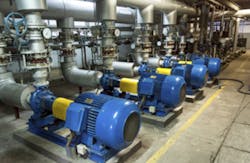The U.S. Department of Energy published April 2 a proposed rule in the Federal Register, which aims to set new energy conservation standards for specific rotodynamic, clean water pumps used in a variety of commercial, industrial, agricultural, and municipal applications.
The standards proposed will primarily affect the pump and pumping equipment manufacturing industry.
DOE does not currently have a test procedure or energy conservation standards for pumps and issued the long-anticipated Notice of Proposed Rulemaking (NOPR) for Energy Conservation Standards for Pumps on March 17. This 257-page document is now available for public review and comment.
In addition, the DOE issued the 270-page NOPR for the Test Procedures for Commercial and Industrial Pumps March 13. The public comment period closes 75 days after publication in the Federal Register for the Test NOPR and 60 days for the Efficiency NOPR.
Under the proposed standards filed April 2 in the Federal Register, a pump model would be compliant if its Pump Energy Index rating is less than or equal to the proposed standard. PEI is defined as the Pump Efficiency Rating (PER) for a given pump model (at full impeller diameter), divided by a calculated minimally compliant PER for the given pump model.
PER is defined as a weighted average of the electric input power supplied to the pump over a specified load profile, represented in units of horsepower (hp).
If adopted, the standards would apply to all equipment defined in the proposal (see Table I.1 of Federal Register notice) and manufactured in, or imported into, the United States on or after the date four years after the publication of any final rule for this rulemaking.
The DOE estimates industry conversion costs for pump manufacturers would be $78.4 million.
DOE says its analyses indicate that the proposed standards would save a significant amount of energy. The lifetime savings for pumps purchased in the 30-year period that begins in the first full year of compliance with new standards (2020-2049) amount to 0.28 quadrillion Btu (quads). This is a savings of one percent relative to the energy use of this equipment in the base case without new standards.
READ ALSO: Hydraulic Institute Responds to U.S. DOE Pump Efficiency Rulemaking
In addition, the proposed standards would have significant environmental benefits, the DOE says. The energy savings would result in cumulative emission reductions of 16 million metric tons (Mt)of carbon dioxide (CO 2), 77 thousand tons of methane (CH 4), 13 thousand tons of sulfur dioxide (SO 2), 25 thousand tons of nitrogen oxides (NO X), 0.23 thousand tons of nitrous oxide (N 2 O), and 0.04 tons of mercury (Hg). The cumulative reduction in CO 2 emissions through 2030 amounts to 2.5 Mt, which is equivalent to the emissions associated with the annual electricity use of 0.36 million homes, according to the DOE. In its analysis, DOE used an analysis period of 2020 through 2049.
DOE estimates that any final rule would publish in late 2015, resulting in a compliance date for the standards in late 2019, four years after the publication date of the final rule.
In considering whether to establish standards for pumps, DOE issued a Request for Information (RFI) on June 13, 2011. The Hydraulic Institute (HI), the leading U.S. industry association for the pumps covered under the proposed rules, has represented its members throughout the DOE rulemaking process since it began in 2011 and intends to respond to the notices on behalf of its members, both in writing and at a April 29 Public Hearing in Washington, D.C.


